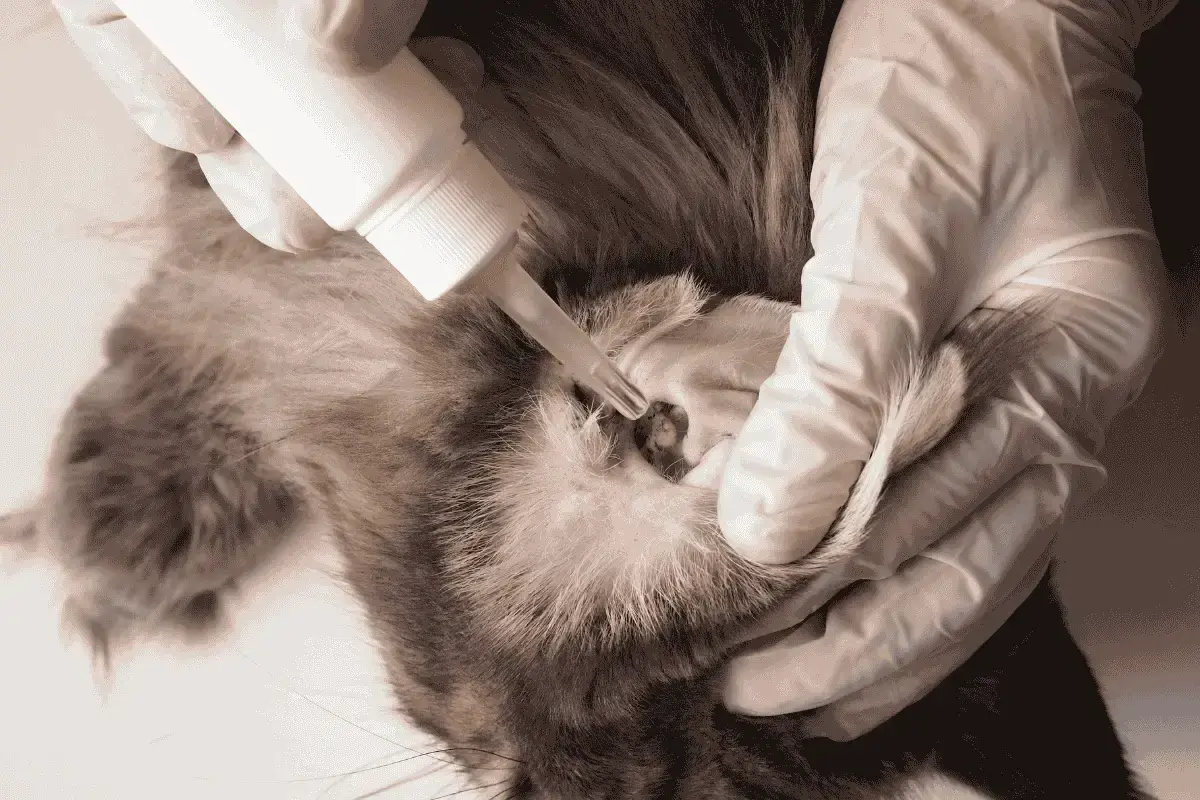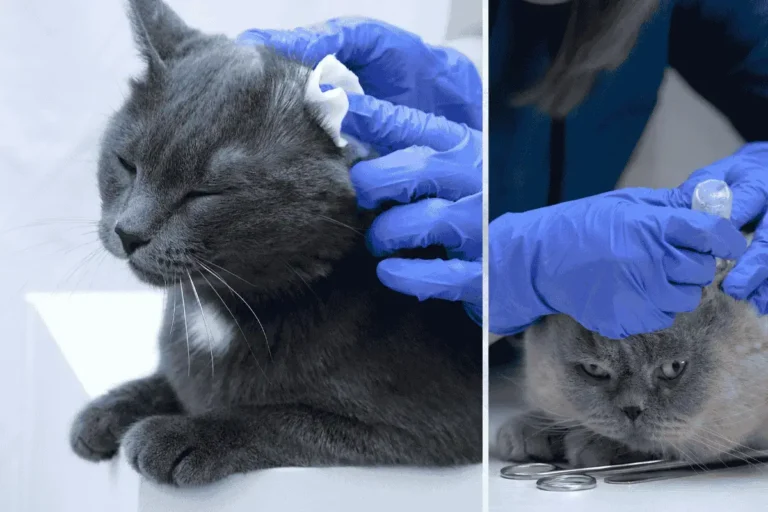Top Symptoms of Ear Mites in Cats and How to Identify Them
Symptoms of ear mites in cats | Is your cat shaking their head or scratching their ears a lot? These could be signs of ear mites. As a cat owner, knowing the symptoms of ear mites is critical to helping your pet. But what causes these parasites, and why are they so important? Let’s explore the truth about ear mites in cats.
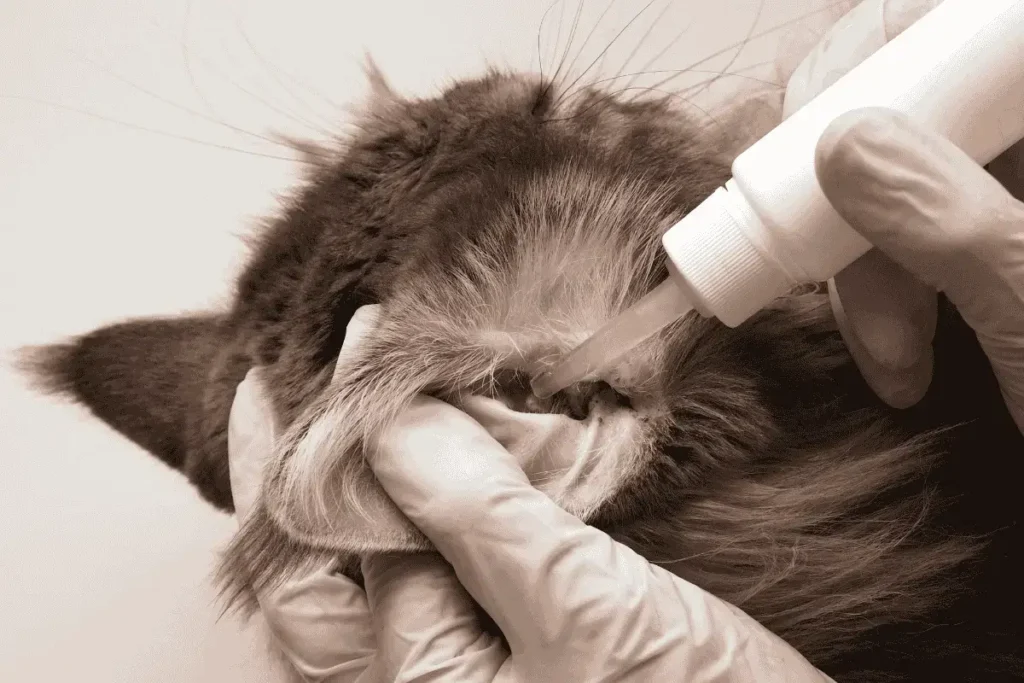
Key Takeaways
- Ear mites are a common problem in cats, causing a lot of irritation and discomfort.
- Look out for symptoms like head shaking, ear scratching, inflammation, hair loss, and a dark, waxy discharge that looks like coffee grounds.
- It’s essential to catch ear mites early and treat them properly to get rid of them and prevent more problems.
- Regular vet visits and preventive steps can help lower the chance of ear mite infections in your cat.
- Both indoor and outdoor cats can get ear mites, so it’s crucial to stay alert and take care of your cat’s health.
Understanding Ear Mites: What They Are and Why They Matter
Ear mites are tiny, eight-legged creatures that live in cats’ ear canals. They are known as Otodectes cynotis and cause irritation and inflammation. Cat owners need to know about ear mites to treat and prevent them.
The Biology of Ear Mites
Ear mites are tiny parasites that thrive in the warm, dark areas of a cat’s ear canal. They mature fast, moving from eggs to adults in only three weeks. Female mites lay their eggs in the ear, and the young larvae soon grow into fully developed mites. Ear mites spread quickly from one cat to another, often through direct contact, grooming, or shared spaces. Kittens and outdoor cats are particularly vulnerable due to their weaker immune systems, making them more likely to pick up these pests.
Why Ear Mites Are a Concern for Cat Owners
Ear mites can be a big problem for cats and their owners. They cause irritation and inflammation in the ear canal. This leads to head shaking, scratching, and discomfort for the cat.
If not treated, ear mites can cause bacterial infections. In severe cases, ear mites may harm the eardrum and even cause hearing loss. Humans can also get ear mites from their cats, so it’s essential to treat and prevent them.
How Cats Contract Ear Mites: Transmission and Risk Factors
Ear mites are contagious parasites that can spread quickly between cats. They can be passed on through close contact or by touching things like grooming tools or bedding. Cats at risk include outdoor pets, those in boarding facilities, and cats adopted from shelters.
Kittens often get ear mites from their mothers. This happens during nursing or when they are in close contact. Cats without regular preventative treatments are also more likely to get ear mites if they’re exposed.
- Your cat can catch ear mites simply by being near an infected animal.
- Cats may contract ear mites by sharing bedding or grooming tools with other infested animals.
- Outdoor pets have a higher risk of contracting ear mites due to increased exposure.
- Ear mites can survive for a short period outside the host’s ear canal.
- Kittens are particularly susceptible to ear mite infestations, often contracting them from their mothers.
- Cats not on monthly preventative treatments are more prone to ear mite infestations if exposed.
Knowing how ear mites spread and who’s at risk is critical for cat owners. It helps them prevent and manage these infestations. By understanding the contagious nature of ear mites and the risk factors, owners can protect their cats.
Symptoms of Ear Mites in Cats: Key Warning Signs
Ear mites are a common problem for cats. As cat owners, knowing the signs is vital in treating them early. This helps keep our cats healthy and happy.
Physical Symptoms and Behavioral Changes
Excessive scratching or head shaking are clear signs of ear mites. Cats with ear mites may seem irritable and restless. They might also lose hair or have inflamed ears with a dark, waxy discharge.
Visual Signs in the Ear Canal
Looking into your cat’s ears can show signs of ear mites. You might see a dark, crumbly substance that looks like coffee grounds. This is a sign of mites in your cat’s ears.
Secondary Complications
Ignoring ear mites can lead to more significant problems. Scratching can cause bacterial infections and even hearing loss. It’s essential to see a vet quickly to avoid these issues.
Knowing the signs of ear mites helps you care for your cat. Regular ear checks and watching for signs can keep your cat healthy and happy.
Identifying Ear Mite Infestations Through Visual Inspection
Spotting ear mite infestations in cats is often accessible with a quick look at the ear canal. Look for fast-moving, tiny white or reddish-brown specks, which are the mites. You might also see a dark, crusty, or waxy discharge that looks like coffee grounds.
Other signs can also point to ear mites. Hair loss or irritation around the ears is common. Cats with ear mites often scratch a lot. You might also notice redness and inflammation in the ear canal.
Even though you can spot ear mites, a vet’s diagnosis is crucial. Other ear problems can look similar. A vet’s exam and tests are needed to confirm the issue and treat it right.
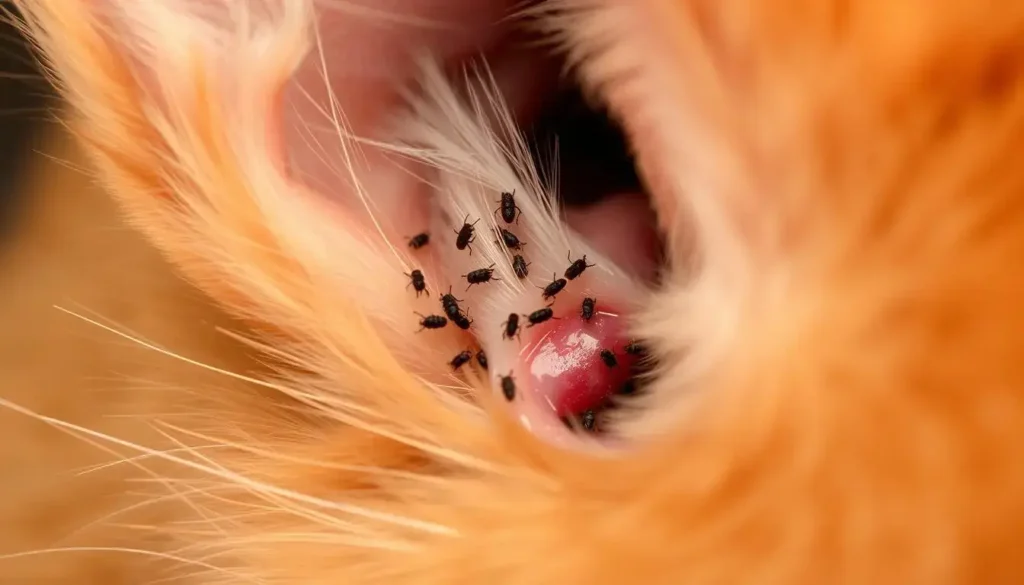
Knowing the signs of ear mites helps cat owners catch problems early. Quick action and vet care are essential. This way, you can solve ear mite issues and avoid future infections.
The Importance of Professional Diagnosis
To treat ear mites in cats, you need a vet’s accurate diagnosis. You might see some signs of ear mites at first. But, a vet’s thorough check and tests are crucial to finding the proper treatment.
Veterinary Examination Process
Your vet will use an otoscope to look closely at your cat’s ear. They’ll search for dark, crumbly debris that shows ear mites. They might also do an ear cytology to check for mites and eggs under a microscope.
Diagnostic Tests and Procedures
- Ear cytology: Examining a sample of ear debris under a microscope to identify mites and their eggs.
- Ear swab cultures: Testing for any secondary bacterial infections that may have developed due to the mite infestation.
- Skin scraping: Checking for mites that may have spread to the cat’s skin beyond the ear canal.
Getting the correct diagnosis is vital in treating ear mites in cats. If you miss the diagnosis, the treatment won’t work. This could make your cat’s condition worse.
“Proper diagnosis and treatment of ear mites is critical to resolving the issue and preventing the spread of these highly contagious parasites.”
Working with your vet is essential. They can give your cat the proper treatment to get rid of ear mites. This will help your cat feel better and stay healthy.
Treatment Options for Ear Mite Infections
Dealing with ear mites in cats can be difficult. But there are good ways to get rid of them. It’s essential to act fast and follow your vet’s advice for the best results.
Topical ear drops are a standard treatment. They contain milbemycin or ivermectin. These are put right in the cat’s ear to kill the mites. This method is very effective if done correctly.
Another choice is monthly treatments like Revolution® or Advantage Multi™. These are applied to the cat’s skin and can clear ear mites in one dose. They work by spreading through the cat’s body.
If a bacterial infection happens, your vet might give antibiotic ointments. In severe cases, steroids might be needed to reduce swelling and pain.
It’s vital to stick to your vet’s treatment plan. Ear mites take 21 days to complete their life cycle. The medicine needs this time to kill all the mites.
Regular vet visits are also crucial. They help make sure the mites are gone and catch any new infections early. With the proper treatment, your cat can feel better and avoid long-term problems.
Home Care During Treatment: What You Need to Know
Adequate home care is critical during ear mite treatment in cats. By following your vet’s advice, you help your cat recover and stop the spread of parasites.
Cleaning and Maintenance
Your vet might suggest using a gentle ear cleanser like Epi-Otic® Advanced. Clean your cat’s ears daily with it, but avoid pushing it too deep. This keeps the treatment working and aids in healing.
Monitoring Recovery Progress
Watch your cat closely during treatment for home remedy for ear mites in cats. Look for signs like less scratching, shaking, and less discharge. Finish the treatment, even if symptoms seem better, to ensure the over the counter topical solution for ear mites in cats works fully.
Make sure to have a follow-up with your vet. This confirms the mites are gone and deals with any new issues.
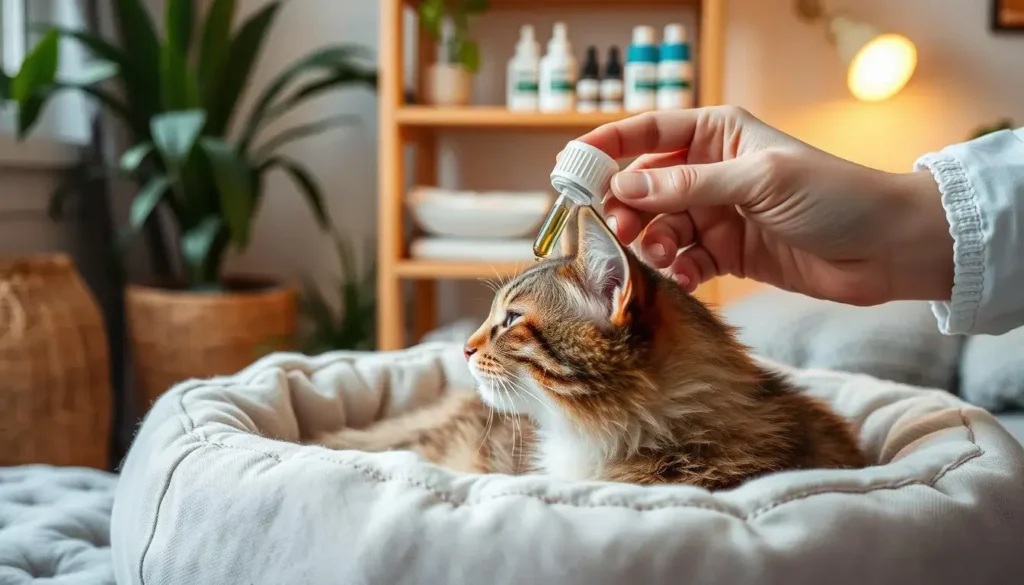
By following your vet’s advice and watching your cat, you can help them recover well. This also helps prevent future ear mite problems.
Preventing Ear Mite Reinfestations in Your Cat
Keeping your cat free from ear mites is vital for their health and happiness. Treating ear mites is essential, but stopping them from coming back is just as crucial. By being proactive, you can protect your cat from these pests.
Using monthly flea, tick, and heartworm preventatives is a great way to prevent ear mite reinfestations. Your vet can prescribe these products. They not only protect against other pests but can also get rid of any remaining ear mites.
Regular ear cleaning is also essential. Use a vet-approved solution to remove wax and debris. This helps prevent mites from thriving. Clean your cat’s ears at least once a week to keep them healthy and mite-free.
- Apply monthly flea, tick, and heartworm preventatives prescribed by your veterinarian
- Clean your cat’s ears weekly with a vet-approved cleaning solution
- Keep infested pets separate from healthy ones until treatment is complete
- Think about keeping your cat indoors to lower the chance of them picking up ear mites.
- Regularly clean your cat’s bedding, toys, and other living spaces to eliminate potential mite habitats.
If your cat has had ear mites, keep them away from other pets until treatment is done. This stops the infestation from spreading to other animals in your home.
Also, keeping your cat indoors can help reduce their risk of getting ear mites. This includes avoiding other infected pets or outdoor areas. Cleaning your cat’s bedding, toys, and living spaces regularly can also help get rid of mite habitats.
By following these steps, you can prevent ear mite reinfestations. This keeps your cat happy, healthy, and free from these annoying parasites.
Common Misconceptions About Ear Mites and Their Treatment
Handling ear mites in cats can be tricky. Many people have wrong ideas about how to treat them. Knowing the truth is vital to keeping your cat’s ears healthy and stopping mites from coming back.
One big myth is that home remedies like rubbing alcohol or vinegar work. They might kill some mites, but they don’t get rid of the eggs. This means mites can come back. Using harsh substances can also hurt your cat’s ears.
Some people think over-the-counter treatments are as good as vet-prescribed ones. But, home remedies for ear mites in cats OTC products might not work as well. Always talk to your vet for the best treatment for your cat.
Ear mites don’t usually spread to people, even if they live with infected cats. But indoor cats can still get them if they meet other sick animals. Getting rid of ear mites takes about a month of careful treatment.
“Ear mites can cause significant discomfort and lead to more serious ear infections if left untreated. Seeking professional veterinary care is the best way to ensure the health and well-being of your cat.”
By clearing up these myths and getting advice from your vet, you can help your cat get rid of ear mites. This will make them feel better faster and for good.
Conclusion
Ear mites in cats are common but can be handled quickly. Spotting signs like hair loss, dark discharge, and scratching helps. Getting a vet’s help and following their treatment plan is critical to getting rid of them.
Preventing ear mites is also essential. Use monthly preventatives and clean your cat’s ears regularly. Getting rid of ear mites in cats often means treating them medically and taking care of them at home.
If you think your cat has ear mites, see a vet right away. Early treatment helps your cat feel better and stops the mites from spreading. Being careful and quick can keep your cat healthy and happy.
FAQ
What are the common symptoms of ear mites in cats?
Ear mites in cats show head shaking and excessive ear scratching. You might see inflammation, hair loss, or irritation around the ears. Look for dark, crusty, or waxy discharge that looks like coffee grounds. Pus and behavioral changes like irritability and restlessness are also signs.
How can I identify ear mites in my cat’s ears?
Fast-moving white spots in the ear canal are ear mites. You’ll also see dark, crusty, or waxy discharge. Hair loss or irritation around the ears from scratching is another clue.
How do cats get ear mites?
Ear mites spread quickly from one animal to another. Cats can get them by touching infected animals or surfaces like grooming tools. Outdoor cats, those in boarding, and shelter cats are at higher risk.
What are the potential complications of untreated ear mites in cats?
Leaving ear mites untreated can result in bacterial infections as a secondary issue. This leads to pain and severe inflammation and can even rupture the eardrum. In severe cases, it might cause hearing loss.
How do veterinarians diagnose ear mites in cats?
Vets use an otoscope to look closely at the ear canal. They might do ear cytology to check for mites and eggs under a microscope. This also helps find any bacterial infections.
What are the treatment options for ear mites in cats?
Treatment includes topical drops like milbemycin or ivermectin in the ear canal. Flea, tick, and heartworm preventatives like Revolution® and Advantage Multi™ are also used. If there’s a bacterial infection, a topical antibiotic ointment is prescribed. Severe cases might need oral or topical steroids to reduce inflammation.
What can I do at home to help treat ear mites in my cat?
Use a vet-recommended ear cleanser like Epi-Otic® Advanced daily. Follow your vet’s instructions for cleaning your ears and applying medication. Watch for signs of improvement, like less scratching and head shaking. Make sure to complete the full treatment.
How can I prevent ear mite reinfestations in my cat?
Prevent reinfestations by using monthly flea, tick, and heartworm preventatives. Clean your cat’s ears weekly with a vet-approved cleanser. Keep infested pets separate until treatment is done. Regularly clean bedding and toys to remove mite habitats.

